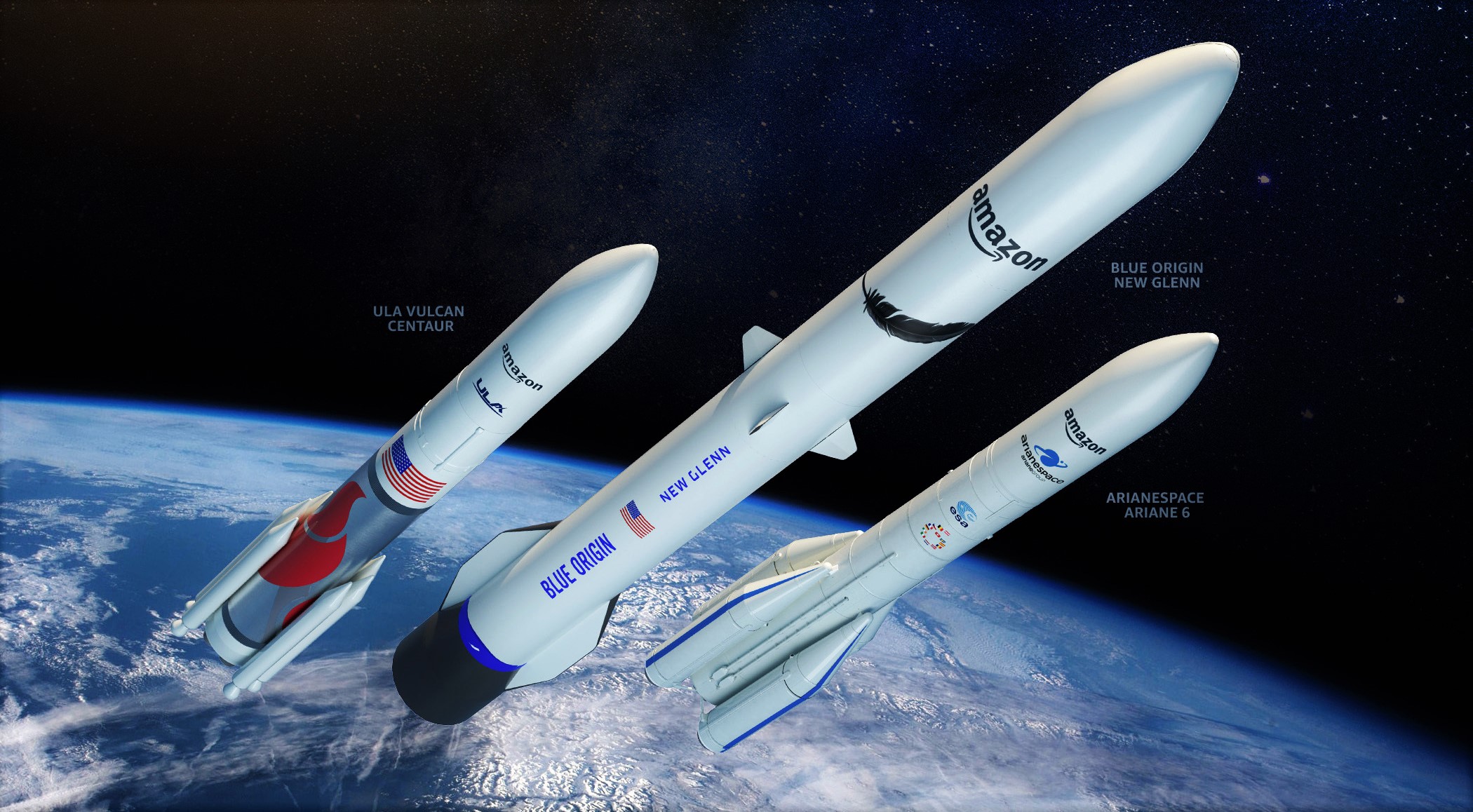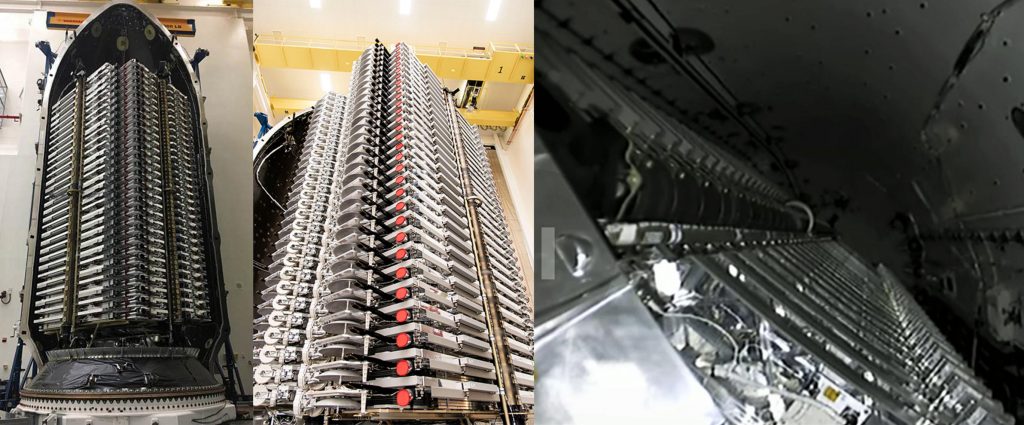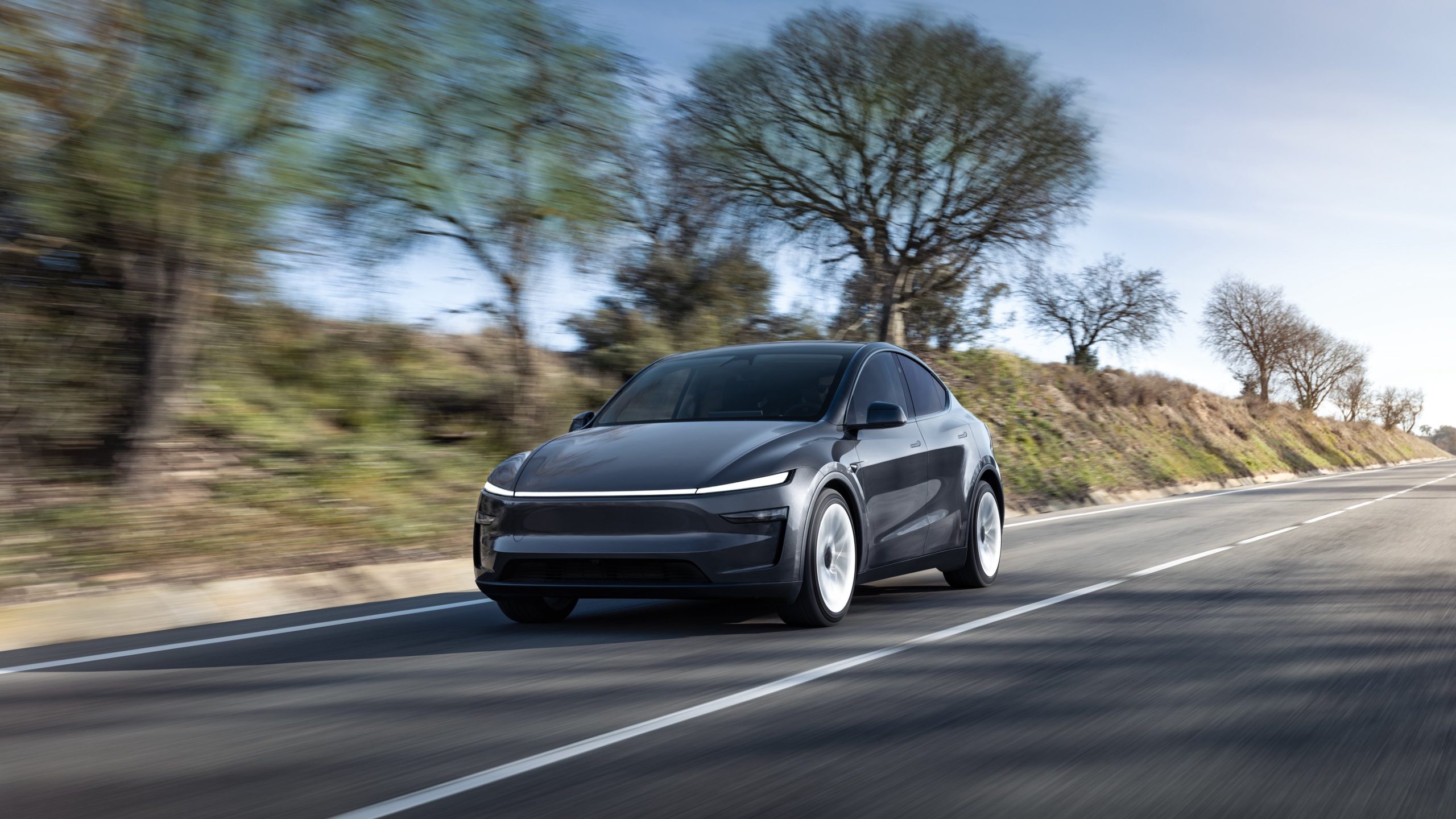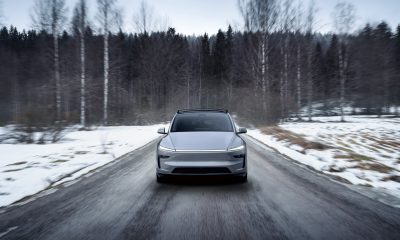

News
SpaceX still an option for future Amazon internet satellite launches, says Senior VP
An Amazon executive says that the company could still call on SpaceX to launch some of its Project Kuiper internet satellites after two of the three unproven rockets it purchased announced launch delays days apart.
Amazon began work on Project Kuiper in 2018. When SpaceX CEO Elon Musk fired several senior employees overseeing the company’s Starlink satellite internet program for being overly cautious, at least two of those employees immediately landed in senior positions at Project Kuiper. Four years later and more than two years after Amazon received an FCC license to deploy its 3,236-satellite Project Kuiper constellation, which aims to compete directly with SpaceX’s Starlink, the company’s first prototype satellite launch has changed rockets and slipped from late 2022 to early 2023.
Of the 77 firm launch contracts Amazon has signed since April 2021, only nine are for a rocket – United Launch Alliance’s (ULA) Atlas V – that has already successfully flown. The remaining 68 (and another 15 exercisable options) are spread among ULA’s Vulcan Centaur, Arianespace’s Ariane 6, and Blue Origin’s New Glenn, all of which are months away from their first launch attempts.
On October 10th, ULA CEO Tory Bruno told reporters that Vulcan Centaur’s launch debut had slipped from its latest late-2022 target to no earlier than (NET) “early 2023.” Garnering 38 of 77 firm contracts, Vulcan is the single most important rocket for Amazon’s Project Kuiper plans and is likely expected to launch close to half of all Kuiper satellites.
Nine days later, Ariane Group and the European Space Agency (ESA) announced that Ariane 6’s launch debut had also slipped from a late-2022 target. Unlike Vulcan’s gentle early-2023 slip, Ariane 6’s debut was pushed to late 2023 at the earliest, and ESA and Ariane officials frankly admitted that that could easily become 2024. Excluding options, Ariane 6 won 18 Project Kuiper launch contracts and is the constellation’s second most important rocket.
Because Amazon applied for its Project Kuiper license so early, a six-year countdown started when the FCC approved its license in July 2020. If Amazon fails to launch half of its 3,236 satellites within six years of that receipt, the FCC could revoke Kuiper’s constellation license. While it’s unlikely that the FCC would actually revoke the license of a constellation that’s close to achieving its deployment milestones, the deadline still emphasizes just how far Amazon and its suppliers are falling behind.
Vulcan, Ariane 6, and Project Kuiper prototype launch delays have only worsened an already challenging situation. In addition to the rocket’s long-awaited debut, ULA has major obligations to NASA and the US military, who expect Vulcan to complete up to four more launches in 2023. Unless ULA pulls off a minor miracle, it’s unlikely that Vulcan will be able to launch five times in its first year of service. Respectively, ULA’s Atlas V and Delta IV rockets took 2.5 and 3.5 years to reach that milestone. If ULA’s past record serves as a reasonable guide for its future, it’s possible that Vulcan Centaur won’t have the spare capacity to begin Project Kuiper launches until 2025.
The same is arguably true for Ariane 6, which has an even busier manifest – all of which may be delayed to 2024. Of Arianespace’s two most recent rockets, Ariane 4 took 14 months and Ariane 5 took 53 months to complete their first five fully successful launches. Ariane 6 borrows heavily from Ariane 5’s design. Unless Arianespace gets off to a record-breaking start or prioritizes Amazon over ESA and other European operators, an almost unthinkable scenario, it’s difficult to imagine that Ariane 6 will have the spare capacity to begin Project Kuiper launches before 2025 or 2026.
Blue Origin’s New Glenn rocket, which is years behind schedule and unlikely to debut before late 2023 or 2024, might ironically be Amazon’s best bet for the first dedicated Project Kuiper launch, but only if its debut is near-flawless and doesn’t slip any further. Given that New Glenn will be Blue Origin’s first orbital rocket of any kind, more delays and issues (if not an outright failure) on the first launch are likely. New Glenn is thus also unlikely to be ready to launch large batches of Project Kuiper satellites until 2024 or 2025. Given the record of its suborbital New Shepard rocket, the odds are also against Blue Origin quickly ramping up the cadence of a far more complex orbital launch vehicle.
Only Atlas V appears to have any significant chance of beginning large-scale Project Kuiper launches before 2025. But ULA is shutting down Atlas V production to transition to Vulcan, so it’s impossible for Amazon to order more than nine of the rockets, as ULA.
Unfortunately for Amazon, in addition to the many rocket-side issues facing Project Kuiper, its satellite prototype delays will make it even harder for the company to begin large-scale launches sooner than later. SpaceX, now the proud owner of a majority of all working satellites in orbit, took around 21 months to go from launching its first two prototypes to its first batch of 60 operational Starlink satellites. The satellite design it settled on was almost nothing like the first two prototypes.

If Amazon’s first prototypes launch on Vulcan’s early-2023 debut, perform excellently, meet or exceed expectations after just a few months of testing, and are close to the final satellite design, Project Kuiper may still have a shot at manufacturing enough satellites to fill one or more launches in 2024. But if its first satellites run into major issues, Amazon’s decision to “[bring] up manufacturing of…production satellites [in parallel with prototype development]” could set it back months if it’s forced to redesign its satellites, find new suppliers, or significantly change the factory it’s already building.
Combined, Project Kuiper finds itself in an unenviable position. It’s thus unsurprising that as of October 2022, an Amazon executive appears to have changed their tune about using SpaceX rockets. Over the last ~13 months, SpaceX has become the single most productive launch provider in the world, besting the entire nation of China. On a quarterly basis, SpaceX now launches more useful mass to orbit than the rest of the world combined. It’s also the only launch provider on Earth that can create spare capacity for last-minute customers by shuffling its own internal launch demands.
According to Dave Limp, senior vice president of devices and services at Amazon, Project Kuiper is willing to consider taking advantage of some of SpaceX’s unprecedented capabilities after it shunned the company entirely in earlier contracts and statements. Speaking in a Washington Post Live interview, Limp says that Amazon is “open to contracting with anyone” and understands “that heavy launch capacity is [and will likely remain] pretty constrained” for years to come.
Unfortunately, Limp began by falsely asserting that Falcon 9 was too small to have warranted earlier launch contracts, stating that it’s “probably at the low end of…the capacity that we need.” In an expendable configuration, Falcon 9 can launch more than 22 tons (~48,500 lb) to low Earth orbit (LEO), while Ariane 6 is quoted at [PDF] 21.7 tons (~47,800 lb). While it hasn’t flown, SpaceX also offers an extended payload fairing that should more or less match Vulcan and Ariane 6’s largest fairings.
But Limp expressed interest in SpaceX’s Falcon Heavy rocket, which could likely match or come close to the payload volume of Ariane 6 and Vulcan and far exceed either rocket’s performance to LEO. In a configuration that would allow SpaceX to recover all three of Falcon Heavy’s boosters, almost guaranteeing that it would cost less than Vulcan or Ariane 6, the rocket would likely be able to launch around 40-50 tons (90,000-110,000 lb) to LEO. The Amazon executive even brought up SpaceX’s next-generation Starship rocket as a more desirable option for future Project Kuiper launches. Starship is designed to launch anywhere from 100 to 150 tons to LEO, should cost even less than Falcon 9 or Falcon Heavy, and will eventually feature a payload bay that dwarfs even New Glenn’s massive fairing.
Nonetheless, despite the promise of SpaceX, Amazon appears to be in no rush to hedge its bets on Vulcan, Ariane 6, and New Glenn. Only time will tell if its multi-billion-dollar gamble pays off.
News
Tesla UK sales see 14% year-over-year rebound in June: SMMT data
The SMMT stated that Tesla sales grew 14% year-over-year to 7,719 units in June 2025.

Tesla’s sales in the United Kingdom rose in June, climbing 14% year-over-year to 7,719 units, as per data from the Society of Motor Manufacturers and Traders (SMMT). The spike in the company’s sales coincided with the first deliveries of the updated Model Y last month.
Model Y deliveries support Tesla’s UK recovery
Tesla’s June performance marked one of its strongest months in the UK so far this year, with new Model Y deliveries contributing significantly to the company’s momentum.
While the SMMT listed Tesla with 7,719 deliveries in June, independent data from New AutoMotive suggested that the electric vehicle maker registered 7,891 units during the month instead. However, year-to-date figures for Tesla remain 2% down compared to 2024, as per a report from Reuters.
While Tesla made a strong showing in June, rivals are also growing. Chinese automaker BYD saw UK sales rise nearly fourfold to 2,498 units, while Ford posted the highest EV growth among major automakers, with a more than fourfold increase in the first half of 2025.
Overall, the UK’s battery electric vehicle (BEV) demand surged 39% to to 47,354 units last month, helping push total new car sales in the UK to 191,316 units, up 6.7% from the same period in 2024.
EV adoption accelerates, but concerns linger
June marked the best month for UK car sales since 2019, though the SMMT cautioned that growth in the electric vehicle sector remains heavily dependent on discounting and support programs. Still, one in four new vehicle buyers in June chose a battery electric vehicle.
SMMT Chief Executive Mike Hawes noted that despite strong BEV demand, sales levels are still below regulatory targets. “Further growth in sales, and the sector will rely on increased and improved charging facilities to boost mainstream electric vehicle adoption,” Hawes stated.
Also taking effect this week was a new US-UK trade deal, which lowers tariffs on UK car exports to the United States from 27.5% to 10%. The agreement could benefit UK-based EV producers aiming to expand across the country.
News
Tesla Model 3 ranks as the safest new car in Europe for 2025, per Euro NCAP tests
Despite being on the market longer than many of its rivals, the Tesla Model 3 continues to set the bar for vehicle safety.

The Tesla Model 3 has been named the safest new car on sale in 2025, according to the latest results from the Euro NCAP. Among 20 newly tested vehicles, the Model 3 emerged at the top of the list, scoring an impressive 359 out of 400 possible points across all major safety categories.
Tesla Model 3’s safety systems
Despite being on the market longer than many of its rivals, the Tesla Model 3 continues to set the bar for vehicle safety. Under Euro NCAP’s stricter 2025 testing protocols, the electric sedan earned 90% for adult occupant protection, 93% for child occupant protection, 89% for pedestrian protection, and 87% for its Safety Assist systems.
The updated Model 3 received particular praise for its advanced driver assistance features, including Tesla’s autonomous emergency braking (AEB) system, which performed well across various test scenarios. Its Intelligent Speed Assistance and child presence detection system were cited as noteworthy features as well, as per a WhatCar report.
Other notable safety features include the Model 3’s pedestrian-friendly pop-up hood and robust crash protection for both front and side collisions. Euro NCAP also highlighted the Model 3’s ability to detect vulnerable road users during complex maneuvers, such as turning across oncoming traffic.
Euro NCAP’s Autopilot caution
While the Model 3’s safety scores were impressive across the board, Euro NCAP did raise concerns about driver expectations of Tesla’s Autopilot system. The organization warned that some owners may overestimate the system’s capabilities, potentially leading to misuse or inattention behind the wheel. Even so, the Model 3 remained the highest-scoring vehicle tested under Euro NCAP’s updated criteria this year.
The Euro NCAP’s concerns are also quite interesting because Tesla’s Full Self-Driving (FSD) Supervised, which is arguably the company’s most robust safety suite, is not allowed for public rollout in Europe yet. FSD Supervised would allow the Model 3 to navigate inner city streets with only minimal human supervision.
Other top scorers included the Volkswagen ID.7, Polestar 3, and Geely EX5, but none matched the Model 3’s total score or consistency across categories. A total of 14 out of 20 newly tested cars earned five stars, while several models, including the Kia EV3, MG ZS, and Renault 5, fell short of the top rating.
Elon Musk
Why Tesla’s Q3 could be one of its biggest quarters in history
Tesla could stand to benefit from the removal of the $7,500 EV tax credit at the end of Q3.

Tesla has gotten off to a slow start in 2025, as the first half of the year has not been one to remember from a delivery perspective.
However, Q3 could end up being one of the best the company has had in history, with the United States potentially being a major contributor to what might reverse a slow start to the year.
Earlier today, the United States’ House of Representatives officially passed President Trump’s “Big Beautiful Bill,” after it made its way through the Senate earlier this week. The bill will head to President Trump, as he looks to sign it before his July 4 deadline.
The Bill will effectively bring closure to the $7,500 EV tax credit, which will end on September 30, 2025. This means, over the next three months in the United States, those who are looking to buy an EV will have their last chance to take advantage of the credit. EVs will then be, for most people, $7,500 more expensive, in essence.
The tax credit is available to any single filer who makes under $150,000 per year, $225,000 a year to a head of household, and $300,000 to couples filing jointly.
Ending the tax credit was expected with the Trump administration, as his policies have leaned significantly toward reliance on fossil fuels, ending what he calls an “EV mandate.” He has used this phrase several times in disagreements with Tesla CEO Elon Musk.
Nevertheless, those who have been on the fence about buying a Tesla, or any EV, for that matter, will have some decisions to make in the next three months. While all companies will stand to benefit from this time crunch, Tesla could be the true winner because of its sheer volume.
If things are done correctly, meaning if Tesla can also offer incentives like 0% APR, special pricing on leasing or financing, or other advantages (like free Red, White, and Blue for a short period of time in celebration of Independence Day), it could see some real volume in sales this quarter.
You can now buy a Tesla in Red, White, and Blue for free until July 14 https://t.co/iAwhaRFOH0
— TESLARATI (@Teslarati) July 3, 2025
Tesla is just a shade under 721,000 deliveries for the year, so it’s on pace for roughly 1.4 million for 2025. This would be a decrease from the 1.8 million cars it delivered in each of the last two years. Traditionally, the second half of the year has produced Tesla’s strongest quarters. Its top three quarters in terms of deliveries are Q4 2024 with 495,570 vehicles, Q4 2023 with 484,507 vehicles, and Q3 2024 with 462,890 vehicles.
-

 Elon Musk4 days ago
Elon Musk4 days agoTesla investors will be shocked by Jim Cramer’s latest assessment
-

 News1 week ago
News1 week agoTesla Robotaxi’s biggest challenge seems to be this one thing
-

 Elon Musk2 weeks ago
Elon Musk2 weeks agoFirst Look at Tesla’s Robotaxi App: features, design, and more
-

 News2 weeks ago
News2 weeks agoSpaceX and Elon Musk share insights on Starship Ship 36’s RUD
-

 News2 weeks ago
News2 weeks agoWatch Tesla’s first driverless public Robotaxi rides in Texas
-

 News1 week ago
News1 week agoWatch the first true Tesla Robotaxi intervention by safety monitor
-

 News2 weeks ago
News2 weeks agoTesla has started rolling out initial round of Robotaxi invites
-

 Elon Musk2 weeks ago
Elon Musk2 weeks agoTesla to launch in India in July with vehicles already arriving: report


















